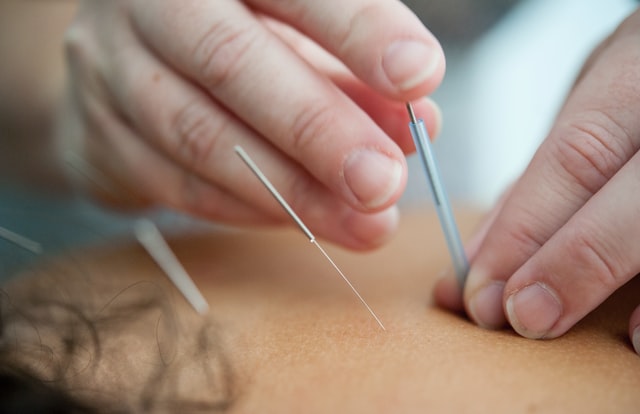Acupuncture is a 2000 year old time-tested, safe and natural, drug-free and extremely effective treatment for all types of pain. It has few minor side effects and can improve your quality of life and complement other medical therapies and treatment.
How can Acupuncture Help?
Regular acupuncture treatments can reduce pain over time by improving blood flow, supporting the release of our body’s natural pain killers (endorphins), and loosening tense or restricted muscles to allow for better circulation and healing. Furthermore, regular treatments can move stagnant blood and acid build up, open and release scar tissue and adhesions, minimize inflammation and reduce numbness and tingling.
Acupuncture aids to restore form, function and flexibility.
In combination, these mechanisms will expedite healing and reduce both chronic and acute pain syndromes.
It is essential to have primary care for chronic or acute pain management (such as your doctor or surgeon), and a thorough investigation is often necessary. Imaging, orthopedic testing, blood work and other interventions are invaluable. Acupuncture is an incredible addition to regular care, helping to speed up healing and reduce reliance on prescription medications.
Treatment:
Typically 4-8 treatments are required to address chronic or acute pain, with electroacupuncture and cupping to support the healing process. Ongoing treatments are often necessary and after an initial course of weekly or 2/weekly treatments, monthly or biweekly maintenance treatments are an excellent option for long-term pain management.
As well, he uses a selection of the 12 acupuncture meridians and points of pain called “ASHI” points in Chinese medicine. Needling these localized points of pain (motor/trigger points) has been termed ‘dry needling’, which is a style of acupuncture that has been practiced for over 2000 years.
Common Conditions Treated with Acupuncture
- Pelvic Pain – Painful periods – Endometriosis
- Back Pain – Sciatica – SI Joint Pain
- Neck / Shoulder Pain – Impingement – Frozen Shoulder – Tension – Whiplash
- Upper Extremities – Carpal Tunnel Syndrome – Tennis Elbow – Golfer’s Elbow – Arthritis – Tendonitis
- Lower Extremities – IT Band Friction Syndrome – Piriformis Syndrome – Plantar Fasciitis – Arthritis
- Injuries – Acute Sprain / Strain – Motor Vehicle – Sports
- Headaches / Migraines

See Research Below
Acupuncture for Chronic Pain
https://www.ncbi.nlm.nih.gov/pmc/articles/PMC4036643/
Journal of the American Medical Association. 2014 Mar 5 955-956
“Acupuncture is associated with improved pain outcomes compared with sham-acupuncture and no-acupuncture control, with response rates of approximately 30% for no acupuncture, 42.5% for sham acupuncture, and 50% for acupuncture.”
Acupuncture for Chronic Pain: Individual Patient data meta-analysis
https://www.jpain.org/article/S1526-5900(17)30780-0/fulltext
Journal of Pain, 2017 Nov 30
“Acupuncture is effective for the treatment of chronic musculoskeletal, headache, and osteoarthritis pain. Treatment effects of acupuncture persist over time and cannot be explained solely in terms of placebo effects. Referral for a course of acupuncture treatment is a reasonable option for a patient with chronic pain.”
Acupuncture for Chronic Pain-Related Depression: A systematic review and meta-analysis
https://www.hindawi.com/journals/prm/2021/6617075/
Journal of Pain and Research Management: Volume 2021
“The results of our current systematic review and meta-analysis show that compared with drug treatment, single acupuncture treatment has the same effect in reducing pain and relieving symptoms of depression in patients with CPRD, but the incidence of adverse reactions of acupuncture treatment is smaller. In addition, acupuncture combined with drug therapy has a better effect than a single drug.”
Acupuncture for Pain
https://www.aafp.org/afp/2019/0715/p89.html
American Family Physician. Am Fam Physician. 2019 Jul 15;100(2):89-96
“In well-conducted systematic reviews, acupuncture has been shown to provide clinically and statistically significant improvement in patients with certain pain syndromes.”





